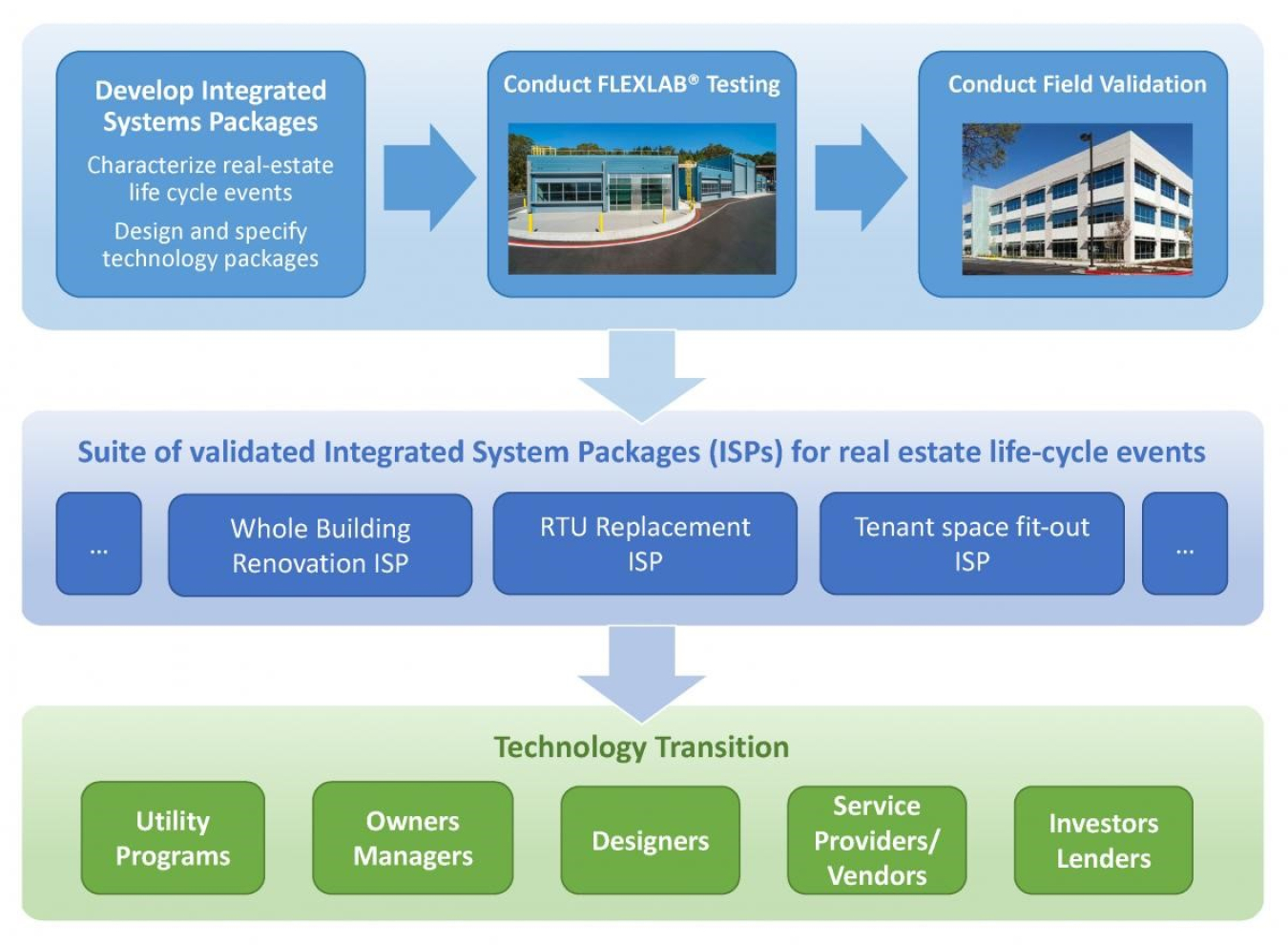The toolkits provide step-by-step information on the technology packages from project applicability checklists to operations and maintenance manuals.
February 6, 2020
Lawrence Berkeley National Laboratory (LBNL), a U.S. Department of Energy lab, has developed a new set of draft integrated systems package (ISP) toolkits for use in commercial buildings. The toolkits, funded by the Office of Energy Efficiency and Renewable Energy’s Building Technologies Office (BTO), provide step-by-step information on the technology packages from project applicability checklists to operations and maintenance manuals.
These ISPs are pre-engineered combinations of energy-efficient technologies that are designed to be implemented seamlessly into the real estate lifecycle of commercial buildings. By optimizing ISPs for routine real estate events, building owners and managers can non-intrusively achieve deep energy savings in existing buildings without sacrificing occupant comfort.
There is growing consensus in the building industry that using a systems approach may become increasingly necessary to achieve meaningful and cost-effective energy savings in the future. However, ISPs remain underutilized for a variety of reasons:
- These projects require significant engineering expertise to ensure they are designed, integrated, commissioned, and operated effectively.
- Building energy retrofits can be disruptive to building occupants when they are not aligned with routine real estate lifecycle events, such as tenant fit-outs, equipment replacements, and renovations.
- Utility incentives, if available, are often only possible through custom programs with narrow eligibility requirements that may entail costly measurement and verification.
- Uncertainty of cost savings and persistence issues remain a real or perceived risk, which can hinder the acquisition of financing for potential projects.
Combined, these barriers impede the implementation of proven, commercially available, state-of-the-art advanced integrated system technologies that would otherwise provide cost-effective energy savings.1
In response to these challenges, LBNL is developing a field-validated, scalable approach to achieve increased building energy savings by finding ways to incorporate ISPs within real estate lifecycle events. The intent of this research is to significantly reduce transaction costs for owners and service providers through technology and business process integration, standardization, and streamlining throughout the real estate delivery chain.2 The final ISPs will streamline planning and installation and provide whole-building energy savings of up to 20%.
The first set of draft ISP toolkits was recently published and is available for download from the Berkeley Lab website. Each of the four toolkits includes key steps for building owners and managers to follow and corresponding resources to facilitate that process. The following is a high-level overview of the five steps and preliminary resources:
Step 1: Use the Applicability Checklist to determine if the ISP is a good fit for the project.
Step 2: Develop requirements with the Owner's Project Requirements Template.
Step 3: Define the scope of work using the provided Technical Specifications.
Step 4: Use the Test Procedures during project commissioning to ensure that the components are functioning as intended.
Step 5: Use the O&M Manual Template to develop maintenance procedures.
At this time, LBNL is offering stakeholders the opportunity to review the toolkits and provide feedback that will be used to shape future versions. Specifically included in the toolkits are draft specifications that can help inform current projects that contain tenant fit-outs, building renovations, and rooftop unit (RTU) replacements. Responses can be emailed to [email protected].
To access more information, provide comments, and stay up to date on the progress of this BTO project, check out the Integrated Systems Package website and the individual ISP toolkit sites below:
- Integrated Systems Package for Tenant Fit-out (Level 1)
- Integrated Systems Package for Tenant Fit-out (Level 2)
- Integrated Systems Package for RTU Replacement
- Integrated Systems Package for Building Renovation
This project includes a partnership with the global real estate firm CBRE, which is providing field validation sites. Project advisors include representatives from ComEd, Environmental Defense Fund, Emcor, Gensler, the U.S. General Services Administration (GSA), NYSERDA, PG&E, Paypal, Rocky Mountain Institute, Therma, TRC, and the Urban Land Institute.
.......
1 For example: Regnier, C., K. Sun, T. Hong, and M.A. Piette. "Quantifying the benefits of a building retrofit using an integrated system approach: A case study." Energy and Buildings 159 (2018).
2 Transaction costs in this context refer to stakeholder investments for system specification, procurement, financing, installation, verification, startup and commissioning, and “soft” factors, such as skill requirements, customer acquisition, amount of stakeholder coordination, and ease of execution.

